Frozen Continent at the Bottom of the World
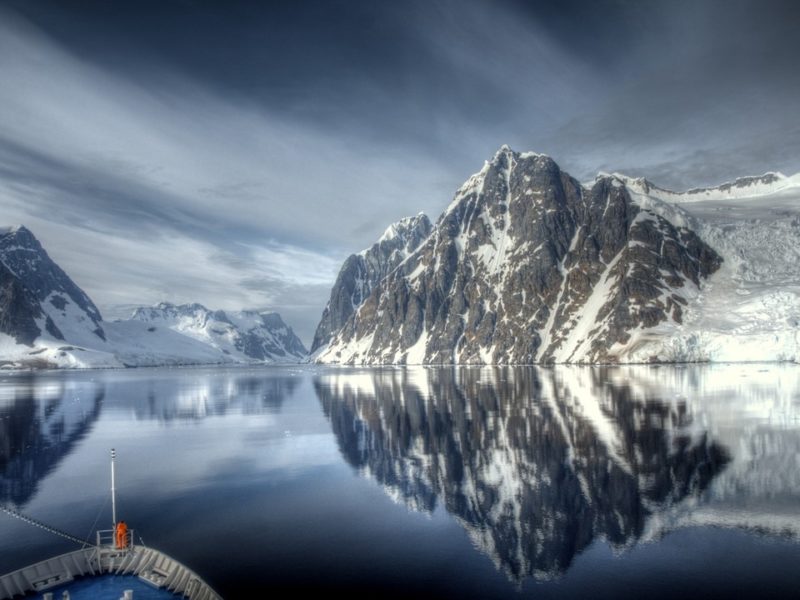
For those who think there is nothing left to seek or nothing left untrammeled, the White Continent at the bottom of the world awaits—serene, magnificent, empty, surreal, and beautiful beyond words. Although the Seventh Continent—larger than the U.S. and Mexico combined—is the world’s most inaccessible, it is no longer a pipe dream for adventurers who place it high on their bucket lists. They return home with tales of a vast wilderness of snow, ice, water, rock and gorgeous, often moody skies. And wildlife, an abundance of wildlife.
The austral summer season runs from November to March, when temperatures on typical afternoons range from the high 20s to the high 30s Fahrenheit. Our mid-November departure with Quark Expeditions was one of the season’s first. Most Antarctic sailings embark and disembark in Ushuaia, Argentina, the gateway to Antarctica (other gateway cities are Christchurch NZ, Hobart in Tasmania, Australia, and Punta Arenas in Chile). The southernmost city in the world, Ushuaia is a ramshackle edge-of-the-world town with a population of 60,000 (though it feels like much less) and an easy base for a precruise visit to the Tierra del Fuego National Park in Patagonia.
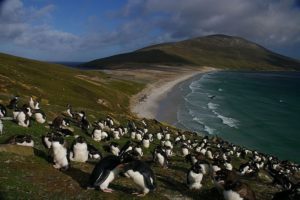
Penguin residents of the Falkland Islands.
Time and budget will determine your itinerary to Antarctica. The popular 11-day expedition sails 600 (sometimes turbulent) miles south across the legendary Drake Passage, the important trade route in the nineteenth and twentieth centuries that was all but eliminated with the opening of the Panama Canal in 1914. The destination is the Antarctic Peninsula, the long sliver of the continent that is the closest point to South America. Those wanting to maximize time on the peninsula can opt for an 8-day option to fly both ways, boarding the ship upon arrival on the peninsula to explore its countless islands and bays, or choose from other expeditions that are also available.
But those heading due south will miss what many of us who sailed northeast from Ushuaia on the longer 20-day itinerary found to be one of the highlights of an experience already heavy with highlights: the inclusion of the far-flung Falkland Islands (Islas Malvinas to Argentines) and South Georgia—sometimes called the Galapagos of the Atlantic, important for its history and wildlife. Together with the grand-finale landing on the continent, we explored three very distinct regions of the Southern Ocean whose topography, climate, wildlife, and history vary greatly.
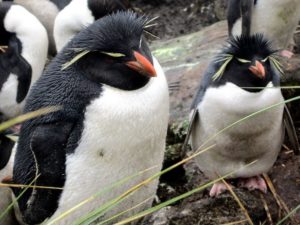
Rockhopper penguins in the Falkland Islands.
The fiercely British enclave of the Falklands is inhabited by some 2,500 friendly British citizens. A stroll through compact and interesting Port Stanley leads past pubs, a tearoom, and neatly tended flower gardens that augment the sense of Great Britain in the middle of nowhere. Four of the world’s eighteen species of penguins live in the Falklands, and they were here in abundance. The aptly named rockhopper with its distinctive yellow feathers was the smallest and most comical of them all (who didn’t know Lovelace from Happy Feet, voiced by the late Robin Williams?).

Elephant seals litter the beach in South Georgia.
But it is Ernest Shackleton who put this area on the map for most history buffs: The British polar explorer managed to save his entire crew after they had been stranded in the Antarctic for almost two years when he appeared on South Georgia Island in 1916 to find help. It is regarded by many to be one of the most astonishing rescue journeys in history. A small cemetery on the island (stunningly beautiful and with massive colonies of penguins) holds his grave—he died here in 1922 during a subsequent expedition. We toasted his remarkable bravery with a plastic cup of Jameson Whiskey, led by Jonathan Shackleton, a cousin and family historian and esteemed guest lecturer aboard Quark’s Ocean Diamond. He joined Falcon Scott, grandson of Sir Robert Falcon Scott, the first Brit to reach the South Pole in 1912. It was like traveling with polar royalty.

Emperor Penguins in South Georgia Island.
The first shore landing by Zodiac on the frozen continent of Antarctica is an emotional moment for everyone—and for many in our party marked the proud accomplishment of having visited all seven of the earth’s continents. Many passengers opted at extra cost for the chance to kayak, and an unexpected 80 percent of the passengers took the polar plunge—I passed on that one, though for one brief minute I considered telling everyone back home (and in this blog) that I did.
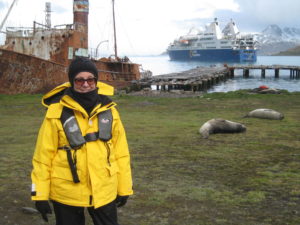
Patricia on South Georgia Island.
The question I received the most: were we ever cold? Spotty Wi-Fi had us aware of the horrible winter conditions back home in New York City; we were far more comfortable in the Frozen South, wearing the layers that Quark had heavily recommended. We ever enjoyed an alfresco barbecue on the deck one evening: eating with our gloves on was a challenge, but well worth the effort to witness the dreamy pastel colors of the sky well past 10 pm.
Every moment spent in this pristine corner of the world was precious, both for the sheer volume of wildlife, the vast and empty size of it all, the ethereal light well into the evening, and the sustained excitement of sharing a very special destination with a special mix of international adventurers.
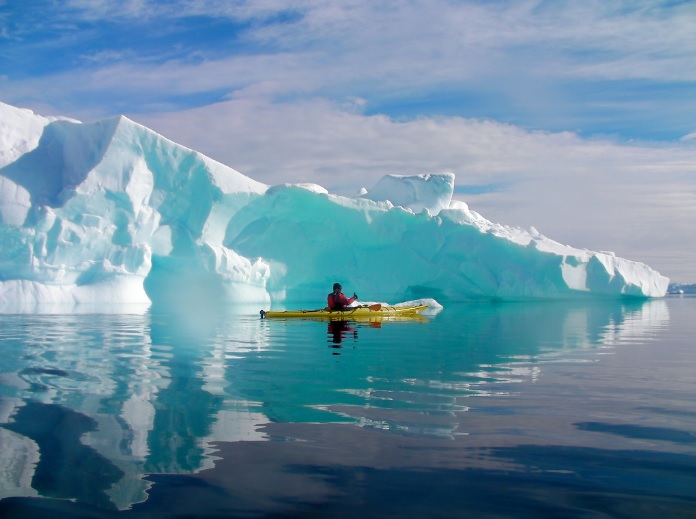
Kayaking in Antarctica is a highlight for many.
“If Antarctica were music, it would be Mozart. Art, and it would be Michelangelo. Literature, and it would be Shakespeare,” wrote Andrew Denton. “And yet it is something even greater; the only place on earth that is still as it should be. May we never tame it.” Amen!

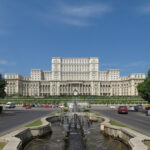
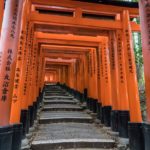
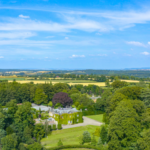
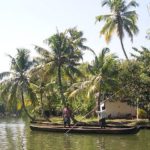
No Comments